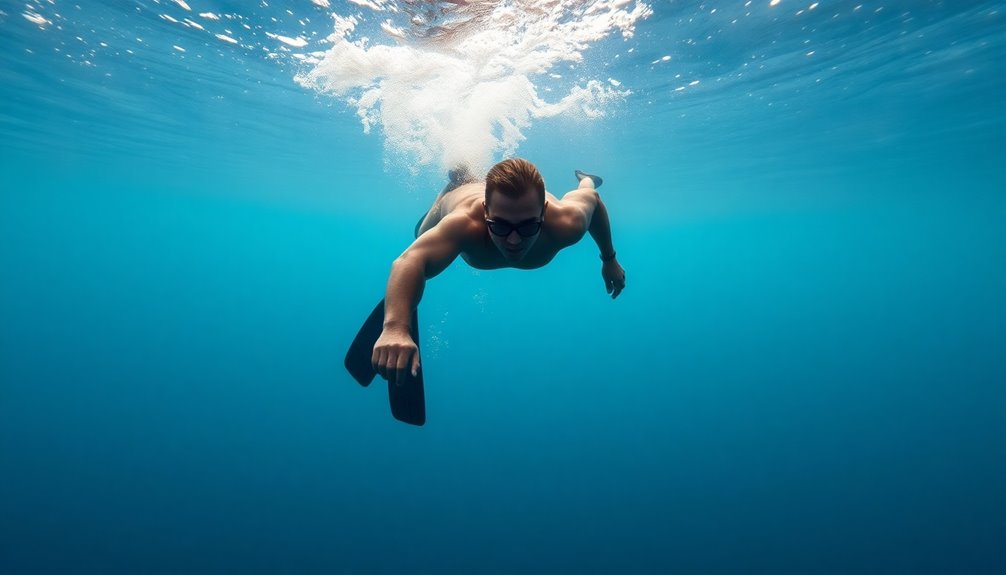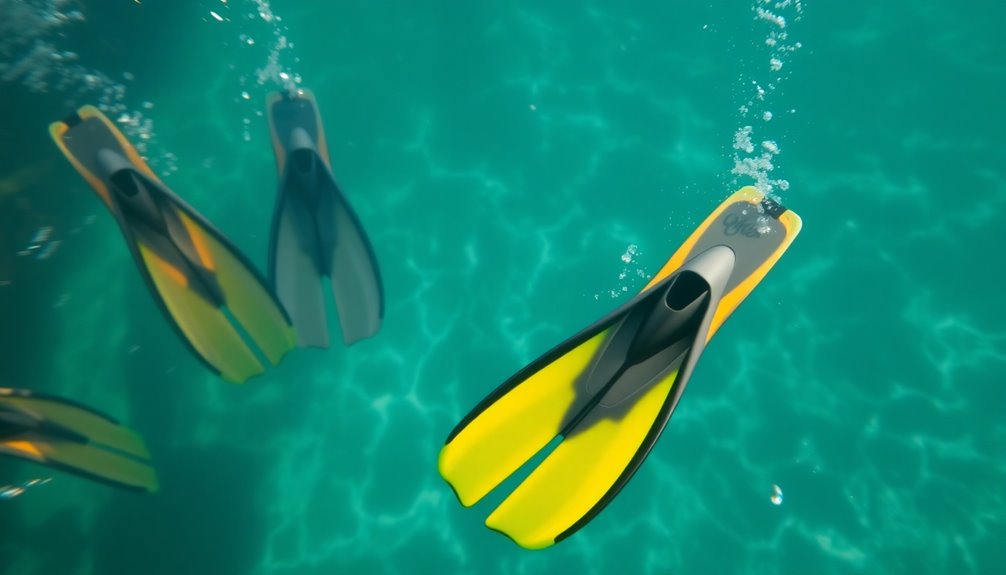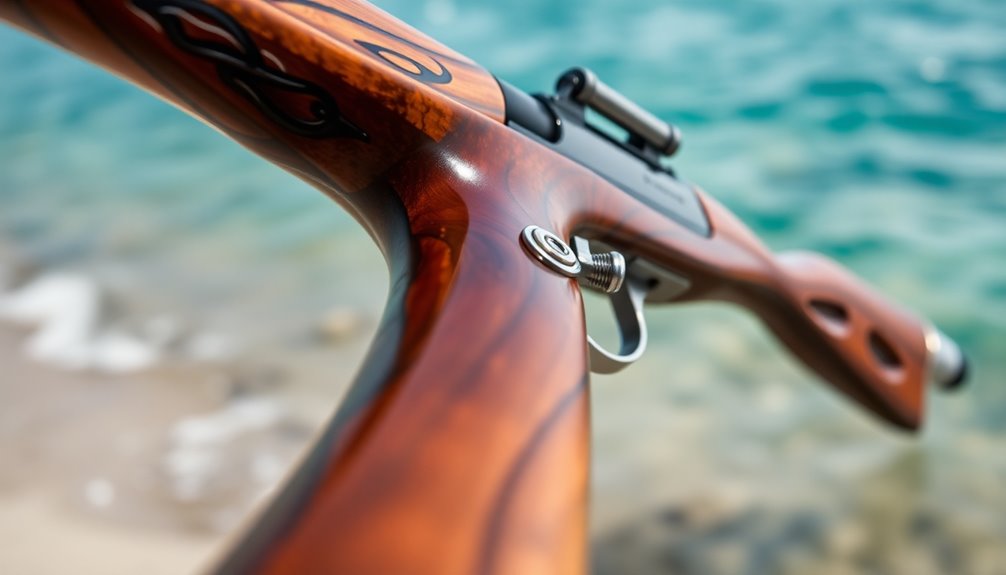Omer fins are shaking up the freediving world with their amazing Italian design! These fins are super lightweight and have special blades that help you glide effortlessly through the water. You'll love their comfy foot pockets, which fit snugly and keep your feet happy. With different stiffness levels, you can choose the best option for your diving style. Plus, Omer fins let you swap parts easily, making them perfect for any diver. If you're curious about how these fins are breaking records and changing the game, you won't want to miss the rest of this exciting story!
Key Takeaways
- OMER fins feature innovative polypropylene blades with a 22-degree angle, enhancing efficiency for freedivers aiming for new performance records.
- The lightweight carbon fiber and Kevlar construction reduces fatigue, allowing divers to push their limits during longer dives.
- Thermo-rubber foot pockets ensure a comfortable fit, accommodating various foot sizes and enhancing overall performance.
- Modular design allows divers to customize their fins, optimizing adaptability for different diving styles and conditions.
- Continuous advancements in materials and design promote energy conservation, improving propulsion and safety for freedivers.
Key Features of Omer Fins

When it comes to freediving, having the right fins can make all the difference, and Omer fins stand out with their innovative design. You'll love their low modular polypropylene blades, which are both durable and resistant to wear and tear. The 22-degree downturned blade angle helps you move efficiently through the water, saving energy and making each dive feel effortless. Plus, with a keyhole in the blade, water flows smoothly, guiding your movements and reducing the effort needed.
Comfort is a big deal, and Omer fins don't disappoint. The foot pockets are made from thermos rubber with different stiffness compounds, ensuring a snug fit that feels great. If you wear neoprene socks, you'll enjoy even more comfort and warmth, especially in cooler waters. Additionally, the fins are designed to be lightweight for ease of use, making them perfect for both casual and serious divers.
The fins also have padding to protect your feet when you walk over rough surfaces. One cool feature is the removable blades, making transportation and maintenance a breeze. Whether you're freediving or spearfishing, these fins are versatile and practical.
With their vibrant colors, they're visible on the surface while blending in with rocky or sandy bottoms. Omer fins truly combine comfort, design, and function for an exciting underwater experience!
Performance Enhancements

Omer fins aren't just about comfort and design; they also enhance your performance in the water. Made from amazing materials like carbon fiber and Kevlar, these fins give you an edge when diving. Carbon fiber fins are super lightweight, weighing only 1 to 1.5 pounds each. They're strong, too! This means you can kick with less effort while still moving quickly through the water.
With Omer fins, you'll notice that you can take fewer kicks. Their long design helps you push more water with each movement, making every kick count. Plus, these fins help reduce fatigue in your legs, so you can dive for longer without getting tired. The smoother, slower kicks allow for better propulsion, which is perfect for deep dives. The OMER Stingray Evo Fins feature a modular design that allows for independent replacement of foot pockets and blades, further enhancing their adaptability for users.
Using the right finning techniques is essential, and Omer fins support this. They let you maintain a relaxed body position, reducing drag as you glide through the water.
Whether you're spearfishing or exploring underwater, Omer fins are designed to help you reach new depths and achieve your diving goals. So, gear up and get ready for an exciting underwater adventure!
Comfort and Fit Options

Finding the right fit for your fins can make all the difference in your diving experience. OMER fins, especially the Stingray foot pockets, are designed with you in mind. Made from a flexible thermo-rubber, these pockets hug your feet comfortably. They come in sizes ranging from EUR 39 to 50, so you're sure to find the perfect match, whether you have smaller feet or not. Additionally, the demand for renewable energy sources in various industries emphasizes the importance of sustainable practices, including in the manufacturing of diving gear.
The Stingray foot pockets offer a soft feel and medium stiffness tendons, ensuring they support your kicks without straining your knees. You can even wear thin socks if you like, adding a touch of comfort for those longer dives. Additionally, the fins are designed to accommodate three stiffness levels, allowing you to choose the best option for your diving style.
Plus, the design allows for easy swapping of blades, making your fins adaptable to different diving styles. With a nice finish and a snug fit, these foot pockets help reduce the risk of leg cramps, letting you focus on enjoying the underwater world.
Understanding Stiffness Levels

Understanding fin stiffness is crucial for enhancing your diving experience and performance.
Choosing the right stiffness level can make a big difference in how you glide through the water. If you weigh between 100-155 lbs, soft fins are your best bet. They're easy on your legs, helping you avoid fatigue. For those weighing 155-200 lbs, medium-soft fins strike a nice balance, offering both comfort and propulsion. Additionally, they are recommended for deep safety rescues due to their versatility. If you're in the 200-255 lbs range, medium fins provide the power you need for deeper dives. Lastly, if you weigh over 255 lbs, hard fins are recommended for maximum thrust.
Pricing and Availability

When it comes to pricing and availability, OMER fins offer a range of options to fit different budgets and preferences. You'll find the OMER Stingray Evo Fins in stock at Spearfishing Store, but specific prices aren't listed.
The OMER Stingray Freediving Fins are available at Beach Cities Scuba and other diving shops, though again, prices vary. Keep in mind, custom fins from other brands can cost anywhere from $485 to $750, so OMER might be a more affordable choice! Additionally, OMER fins are designed with protection against UV rays, making them durable for long-term use.
You can easily find OMER fins through global distributors listed on their official website or by shopping online. They offer various sizes to fit different foot measurements, so you're sure to find the right pair for you.
Some retailers even provide size measurement guides to help you choose the best fit. Plus, if you order from certain places like Beach Cities Scuba, you get free 30-day returns! This means you can try them on in the comfort of your home without worry.
With all these options, you'll be ready to dive into your next adventure with OMER fins!
User Experiences

User experiences with OMER fins highlight their comfort, fit, and performance across various diving scenarios. Many users rave about how the thermo-rubber foot pockets hug their feet just right, making them feel flexible and snug.
While they might need a little time to break in, the initial comfort is impressive. With sizes ranging from EUR 39 to 50, there's a fit for almost everyone. Wearing 2 mm to 3 mm neoprene socks can enhance that snug feeling even more.
When it comes to performance, divers notice an incredible boost. The fins help you glide effortlessly through the water, even at the surface. Once you dive deeper, up to 50 feet, the efficiency truly shines. This is particularly important as increased freediving accidents have prompted a focus on safety in fin design. The streamlined design and flexibility of these fins allow divers to propel into the blue with minimal effort, conserving energy and prolonging their time underwater. The enhanced performance also provides a sense of security, as divers can navigate currents and sudden changes in water conditions with ease. In addition to the boost in performance, the safety features incorporated into the fin design offer reassurance for divers exploring the depths.
They're especially handy if you're carrying heavy gear like cameras. Plus, the long, light design reduces fatigue in your legs, letting you kick smoothly.
It's important to remember that the stiffness might take some getting used to, and you might feel a little cramping at first. However, with a few dives, your muscles will adapt, allowing you to enjoy a wonderfully enhanced diving experience.
OMER fins make every dive feel exciting and effortless!
Comparisons With Other Fins

OMER fins, while praised for their comfort and fit, face stiff competition when compared to other options on the market. Their UP-F1 fins feature a unique foot pocket design that some divers love. However, the carbon blades aren't as highly regarded as those from brands like Speardiver or Cressi. You might find that OMER fins are lighter and less flexible, which can make them feel less efficient for deep diving.
When it comes to spearfishing, OMER fins may not be your best choice. Fins like the Seac Motus Kama or Mares Avanti Quattro Power offer better maneuverability and power. These fins are shorter and stiffer, making them a favorite for handling tricky conditions. Additionally, the ribbed, four-channel blade structure of the Mares Avanti Quattro Power enhances water flow and flexibility, improving propulsion for divers.
Moreover, the fit of OMER foot pockets can vary, and they mightn't always pair well with carbon blades. You could find that Cressi Gara Modular pockets provide a more comfortable fit, helping you dive longer.
In a nutshell, while OMER fins have their strengths, exploring other options can lead to a more enjoyable and productive freediving experience!
Innovations in Freediving Technology

Innovations in freediving technology have transformed the way divers experience the underwater world. Imagine gliding smoothly through the ocean with fins made from lightweight carbon fiber. These fins are super strong and flexible, allowing you to kick less while going deeper and exploring more.
With modern designs, you can enjoy better propulsion, so you conserve energy for longer dives! The addition of nano-materials in the composite structure enhances the durability and resilience of the fins, making them even more reliable for challenging underwater conditions.
A cool feature of today's fins is their modular design. This means you can easily switch parts around, like the foot pocket or blade, to match your diving needs. Plus, using advanced materials, like nano-composites, ensures your fins won't break easily, even in tough conditions.
Safety is key!
You might also find exciting tools like diver propulsion vehicles, or scooters, that help you dive deeper without using too much energy.
And with oxygen-enriched gas mixes, you can dive longer and safer. These innovations make freediving not just a sport but a thrilling adventure!
Frequently Asked Questions
How Do I Properly Care for My Omer Fins?
To care for your Omer fins, rinse them well after each use, especially if you've been in salt or chlorine water.
Let them air dry away from direct sunlight.
When storing, keep them flat on a shelf, not hanging by the straps.
Regularly check for wear and tear, and replace any damaged parts quickly.
This way, your fins will stay in great shape, ready for your next adventure!
Can I Customize the Colors of My Omer Fins?
You can't customize the colors of your OMER fins. They come in a specific color designed for visibility on the surface and to blend in with rocky and sandy bottoms.
While you can't choose different colors, the fins are made for performance and functionality.
Plus, they've a modular design, so you can upgrade parts like the blades later on.
Enjoy diving with these awesome fins that are made for you!
Are Omer Fins Suitable for Snorkeling as Well?
Omer fins aren't really the best choice for snorkeling.
They're designed for freediving, with long, stiff blades that help you dive deep but make it hard to turn or maneuver in shallow waters.
You might find snorkeling fins are better because they're shorter and more flexible, allowing for easier movement.
If you want to explore coral reefs or swim near the surface, softer fins would give you more fun and control!
What Is the Warranty Policy for Omer Fins?
Omer fins come with a 2-year warranty, which covers defects in materials and workmanship.
This warranty starts from the day you buy them. If you use the fins for fun or sport, you're good!
But if they get misused or worn out too much, the warranty won't cover that.
Keep your proof of purchase handy, and if you need help, just contact your Omer dealer for assistance!
Enjoy your adventures!
Where Can I Find Replacement Blades for Omer Fins?
You can find replacement blades for OMER fins at several places.
Check out spearfishing stores, like the Spearfishing Store, which has OMER Stingray Evo fins replacement blades.
House of Scuba also sells OMER products, so they might've what you need.
Don't forget online marketplaces, like Amazon or eBay.
Always make sure the blades are compatible with your specific fin model, and enjoy your underwater adventures!
Conclusion
In conclusion, Omer fins are an exciting choice for freedivers looking to push their limits! With amazing features that boost performance and keep you comfortable, these fins truly stand out. Understanding stiffness levels helps you pick the perfect fit, and the user experiences show how much fun they bring. So, if you're ready to dive deeper and chase new records, Omer fins can help you make a splash in the world of freediving!










